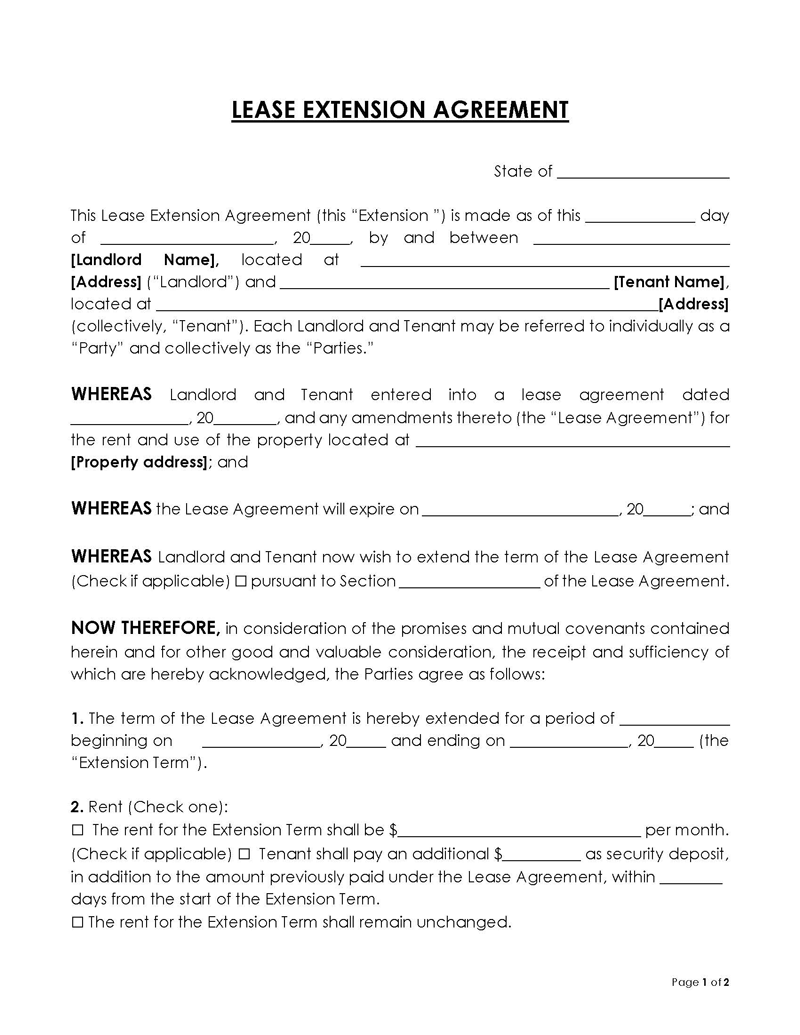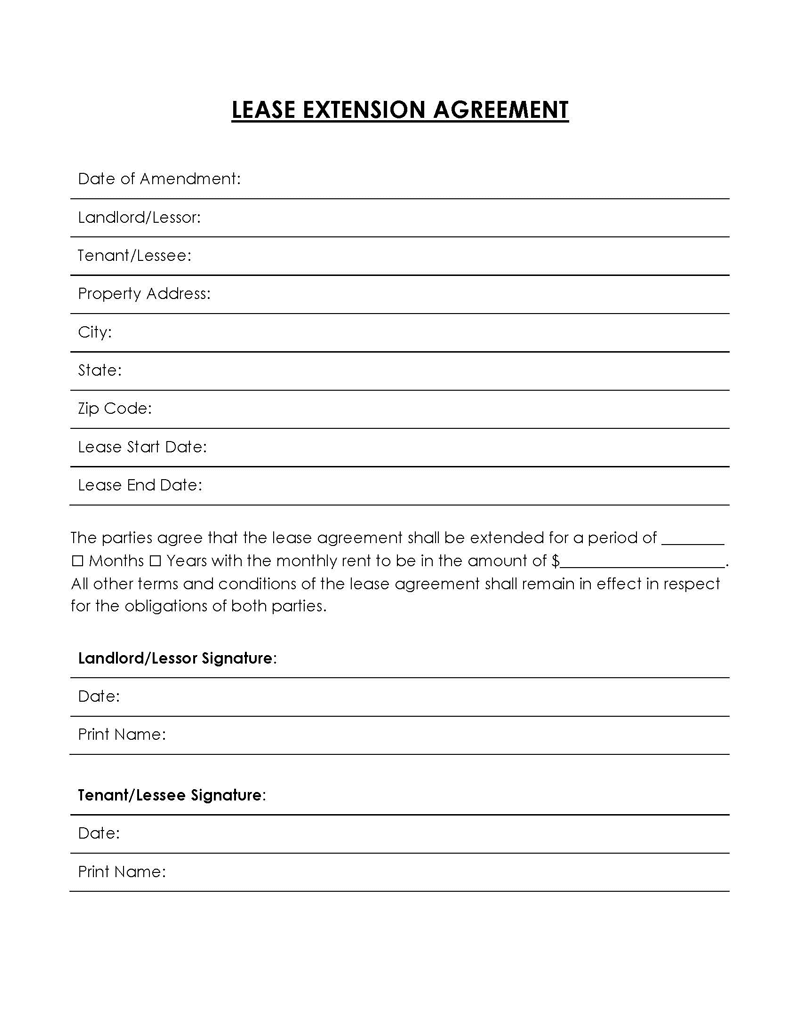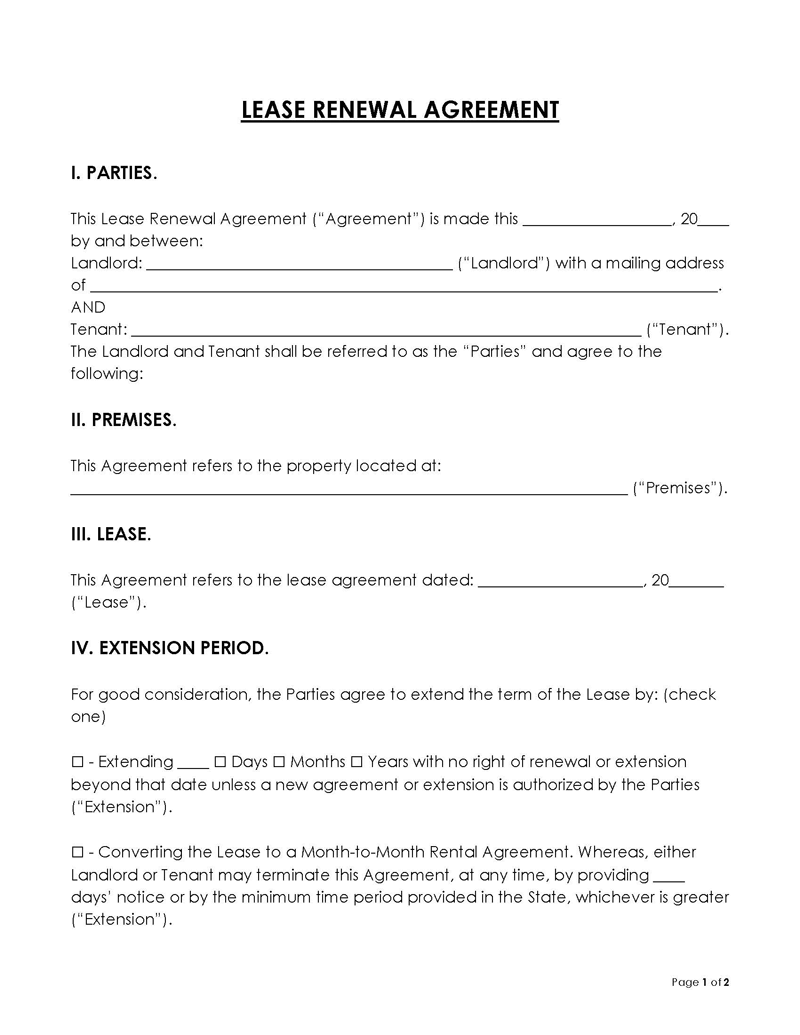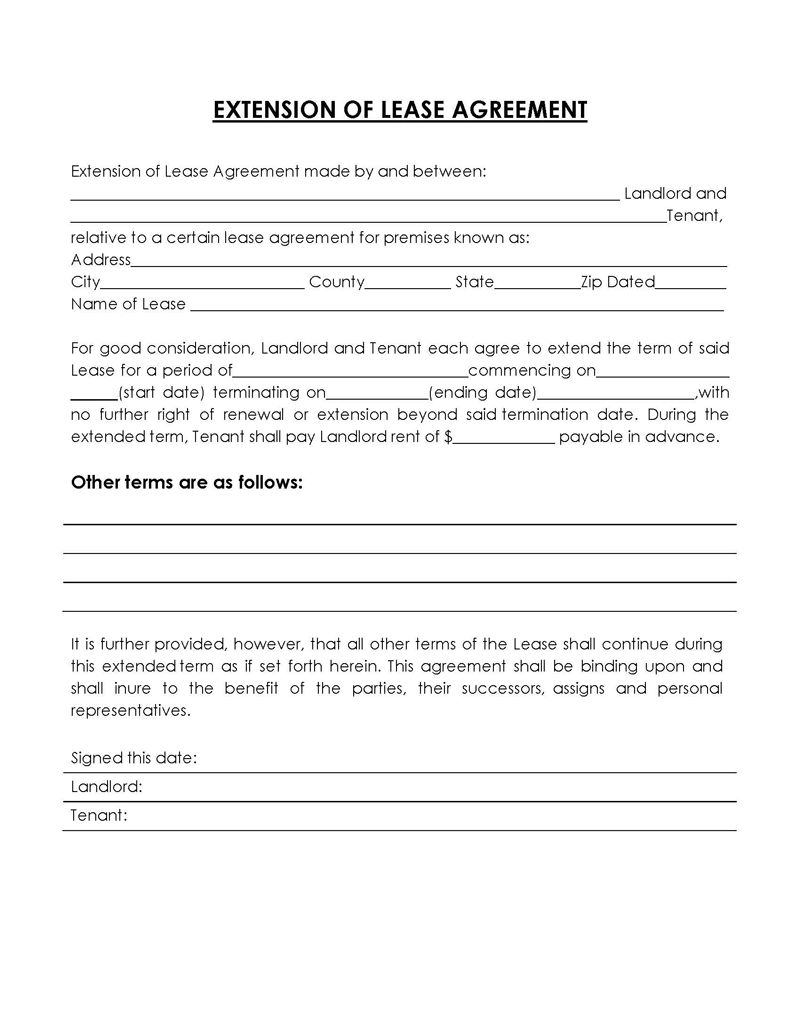Lease agreements are time and again extended after expiration. A lease extension is pursued when tenants want to continue occupying the rented property either short-term before they find a new place or long-term for a significant lease period. Landlords also pursue this option when they want to retain reliable tenants and don’t want to undergo a rigorous screening process. A lease extension can thus benefit both parties to a lease agreement.
Also, it is less frustrating than lease renewal, which involves renegotiating lease terms. However, such a renegotiation can result in a rent increase during good economic times or a rent decrease during tough economic times, making the lease less favorable to one of the parties.
This article will elucidate what a lease extension agreement includes, how it works and how to extend an existing lease agreement.
Free Templates for You
Given below are the lease extension agreement templates:
What is a Lease Extension?
A lease extension agreement is a written contract between a landlord and tenant that extends the length of an existing rental agreement.
It’s used when the original term expires or when there needs to be a gap between tenancy periods. The renewed lease retains the terms and conditions of the original lease unless modifications are incorporated.
The extension can last from several days to a few months. So, the rent can remain unchanged unless the landlord increases it to align with economic conditions. The amount paid by the tenant will then be prorated based on the added rental period. Lease extensions will typically be exercised before the original lease expires.
However, a lease extension is not mandatory in any lease arrangement. Lease renewals are standard in different lease arrangements, from commercial property to residential real estate, machinery, vehicles, etc.
How Does it Work?
Lease extensions are contracts between the landlord/lessor and tenant/lessee. A lease extension occurs at the end of an existing lease. This is when a lessee will often have the option to move out/vacate the rented space, renew the lease or seek an extension of the lease they are already in. In some cases, the first two options may not be viable or favorable for both parties as it would require seeking a new place or renegotiating lease terms. That’s when the third option of extending the existing lease is pursued.
With a lease extension, the lease terms of the original arrangement remain in effect for an extended period. The lease will typically be extended for a short definite timeframe. The lessor and the lessee then agree upon the new expiration date. Alternatively, the lease can be extended on a month-to-month basis.
Both parties must sign the contract for the extension agreement to be enforceable. Also, certain information must be presented in the document. This includes identification information of both parties, extension period (start and end date), and reference to the original lease agreement. In certain instances, lease extensions can be automatic. Lastly, note that leases are executed when renting tangible items or assets/property such as vehicles, equipment, plans, or any other.
Extension Vs. Renewal
These two terms are repeatedly used interchangeably, but there’s a subtle difference between them. Extension refers to prolonging the lease term of an existing lease agreement. Renewal refers to the process of two lease agreement parties choosing to renegotiate terms and create an entirely new arrangement.
The right choice between extension and renewal depends on several factors, including financial situation and convenience. A lease renewal accords certain flexibility such that rent can be increased and terms and conditions can be modified or added if needed. This flexibility is not available in a lease extension agreement.
Extending a Lease
Extending a lease is beneficial for both parties if the current arrangement is satisfactory. Both parties can continue their arrangement without renegotiating lease terms or finding a new location and replacement for landlords.
Below is an informative guide on how to extend a lease agreement:
Find the original lease
This involves locating the original lease agreement, which should be in writing and signed by both parties. Next, verify the expiration date and rent amount. Note the rent amount can often be renegotiated depending on the current economic conditions.
Contact the other party
Contact the other party of the original lease agreement to notify them of your interest in extending the lease. This should be done before the original lease expires. You can also use this opportunity to seek an extension of the original and favorable conditions or revised terms. Contact can be made via a phone call, letter, or email.
Send the extension addendum
Once the landlord has agreed to a lease extension, they or the property manager will draft a document that details the extension. The extension addendum should highlight any changes to the original agreement, including rent amount, length of term, and other outstanding changes (if any). If no changes other than the rent and lease terms are made, it is presumed that the rest of the original lease agreement will remain in effect. The addendum should then be sent to the tenant.
Sign the agreement
Once the tenant reviews the extension addendum, they should meet with the landlord for signing. The document should be signed in person but can be signed electronically if preferred by the parties and permitted within the jurisdiction.
Factors to Consider
A lease extension agreement can be a win-win situation for both parties, but it’s essential to consider various factors before agreeing.
The following factors can influence the decision to extend/renew a lease:
- First, both parties should consider the risk involved in extending the lease. This is in terms of financial risk and stability. Stability is an advantage for both parties. It gives them ample time to re-evaluate their situation and determine whether it is best to extend or terminate the existing rental period. Also, whether the rent is increased or lowered, it could be a risk to either party. An extension offers the tenant some stability as they won’t have to move out, which can also be a risk to the landlord as they won’t be able to revise the tenancy terms.
- In business, companies will lease space as an asset with a lower financial risk than buying. Leasing ensures the company doesn’t bear the risk of land price fluctuations. It is thus necessary for businesses to consider this factor before extending a lease.
- Additionally, when it comes to leasing equipment, lease extensions are common when companies want to continue using hired equipment instead of buying and disposing of purchased equipment after it is no longer helpful. This saves companies time and money in disposing of equipment in the future.
How to Write?
The standard writing format must be followed when writing a lease extension agreement. This includes addressing the details of both parties, effective date, extension period, terms and conditions that will be in effect after the agreement has been signed, and, finally if there are any changes to the original lease agreement.
Below is an illustrative guide on how to write a lease extension document:
Specify the lease extension date
The first component of the agreement should be the date when the document was prepared. This marks the date the original lease was amended. Next, specify the day, month, and year.
Name the landlord
Next, indicate the name of the landlord/lessor. Their full name should be provided strictly as it appears in the original lease agreement. They should be designated as the “landlord/lessor.”
Identify the tenant
Then, write down the name of the tenant/lessee precisely as given in the existing lease agreement. The tenant should be identified as “the tenant/lessee.”
Document the location of the concerned property
You should write down the address of the property. This information should be given as per the records of the original agreement. If there’s a street address, give it as well. The jurisdiction should also be indicated by indicating the city and state.
Lease start and end date
Next, indicate the lease extension agreement’s commencement and termination dates. Again, the dates should be specific and incorporate the day-month-year.
Extension period
Enter the length of time in which the lease will be extended. This can be a month-to-month or fixed lease extension. Again, this length can be given in terms of months or years.
Specify the rent collection procedure
The amount of rent is another critical aspect that should be included in the lease extension agreement. The amount should be precise regarding the exact figure and respective currency unit. If all other initial lease terms remain unchanged, a statement that clarifies this should be provided. If any changes or modifications to the terms or conditions of the existing lease are to be implemented, they should be outlined.
Landlord and tenant’s signature
Lastly, signing them can signify both parties’ acceptance of all terms of the document. Therefore, each party should attach their signature to the lease extension and indicate the date of signing.
Lease Extension Agreement
Landlords and tenants can create lease extension agreements using fillable extension agreements. Our readers can access such templates from our site. The templates simplify the writing process as they outline the critical components of a standard lease extension, thus requiring the user to input the required information simply. In addition, the extension agreements are readily downloadable and can be personalized to suit the user’s requirements.
Effective Practices
The document should be written in clear, simple, and understandable language that doesn’t result in confusion and misinterpretations.
Below are some effective practices for writing a lease extension agreement:
Put it in writing
The document is proof of every term and provision agreed upon by both parties. The lease extension, like the original agreement, should be in writing. It shouldn’t be concluded verbally as it can be interpreted differently based on the inference of the person reading it. As it is a legally binding agreement, there needs to be evidence to prove what was agreed upon between the parties, more so in case of a dispute. Without a written document, the lease extension would not be enforceable under law.
Therefore, the lease and other correspondence should be in writing, like the lease extension notice or letter. All relevant details, including addresses, property, dates, name of the landlord, tenant, and any other information necessary for understanding the agreement, should be itemized clearly. The extension request letter is essential to convey the reasons for the request and serves as a record of the arrangement. The letter can request a decision within 10 to 2 weeks.
Timing is everything
The request to extend the lease should be made before the initial lease expires. This can be anywhere between 30-60 days before the lease expiration date. This gives the landlord enough time to decide if they agree to the extension and, if they’ve found a replacement, to set the replacement’s move-in date past the lease extension end date.
Give the landlord something in return
Extending the lease gives the tenant security of tenure and some level of continuity. However, to guarantee a smooth transition and avoid rejection, tenants need to consider what value they offer in return. The incentive can be a prorated rent amount. For example, if the extension is for another 30 days, they should offer a rent amount equivalent to the lease extension period.
Key Takeaways
- A lease extension is a form of contractual modification that allows a tenant to extend the lease of their premises by another term, either short-term or long-term.
- When executing a lease extension agreement, both parties must have an equitable amount of advantage when agreeing to extend the lease agreement. As a result, the tenant enjoys continuity of their tenancy while the landlord enjoys continuity of income.
- For a lease extension to occur, it can only be requested before the original lease expires through a lease extension request letter.
- Lease extension agreements often depend on whether or not the landlord accepts the request of their tenant(s).
- The lessee and the lessor should sign the lease extension agreement to be binding and enforceable under law.



